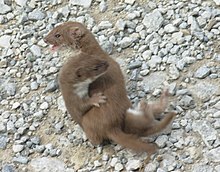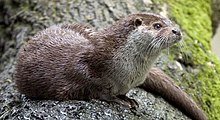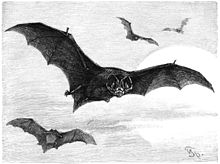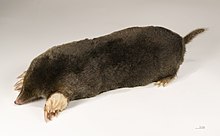This is a list of the mammal species recorded in Andorra. There are seventy-nine mammal species in Andorra, of which three are vulnerable, ten are near threatened, and two are endangered.
The following tags are used to highlight each species' conservation status as assessed by the International Union for Conservation of Nature:
| EX | Extinct | No reasonable doubt that the last individual has died. |
| EW | Extinct in the wild | Known only to survive in captivity or as a naturalized populations well outside its previous range. |
| CR | Critically endangered | The species is in imminent risk of extinction in the wild. |
| EN | Endangered | The species is facing an extremely high risk of extinction in the wild. |
| VU | Vulnerable | The species is facing a high risk of extinction in the wild. |
| NT | Near threatened | The species does not meet any of the criteria that would categorise it as risking extinction but it is likely to do so in the future. |
| LC | Least concern | There are no current identifiable risks to the species. |
| DD | Data deficient | There is inadequate information to make an assessment of the risks to this species. |
Order: Artiodactyla (even-toed ungulates)

The even-toed ungulates are ungulates whose weight is borne about equally by the third and fourth toes, rather than mostly or entirely by the third as in perissodactyls. There are about 360 artiodactyl species, including many that are of great economic importance to humans. This group also includes cetaceans.
- Family: Suidae (pigs)
- Family: Cervidae (deer)
- Subfamily: Cervinae
- Genus: Cervus
- Red deer, C. elaphus LC
- European red deer, C. e. elaphus
- Red deer, C. elaphus LC
- Genus: Dama
- Fallow deer, D. dama LC introduced
- Genus: Cervus
- Subfamily: Capreolinae
- Genus: Capreolus
- Western roe deer, C. capreolus LC
- European roe deer, C. c. capreolus
- Western roe deer, C. capreolus LC
- Genus: Capreolus
- Subfamily: Cervinae
- Family: Bovidae (bovids)
- Subfamily: Bovinae
- Genus: Bos
- Domestic cattle, B. taurus (introduced)
- Genus: Bison
- European bison, B. bonasus NT
- Genus: Bos
- Subfamily: Antilopinae
- Genus: Capra
- Iberian ibex, Capra pyrenaica LC
- Pyrenean ibex, C. p. pyrenaica EX
- Western Spanish ibex, C. p. victoriae (introduced)
- Iberian ibex, Capra pyrenaica LC
- Genus: Ovis
- Domestic sheep, O. aries NA
- Mouflon, O. gmelini NT (introduced)
- Genus: Rupicapra
- Pyrenean chamois, R. pyrenaica LC
- Pyrenean chamois, R. p. pyrenaica
- Pyrenean chamois, R. pyrenaica LC
- Genus: Capra
- Subfamily: Bovinae
Order: Perissodactyla (odd-toed ungulates)
The odd-toed ungulates are browsing and grazing mammals. They are usually large to very large, and have relatively simple stomachs and a large middle toe. There are only around 20 species of perrissodactyl.
- Family: Equidae (horses & allies)
- Genus: Equus
- Wild horse, E. ferus
- Domestic horse, E. f. caballus introduced
- Wild horse, E. f. ferus EX
- Donkey, E. asinus introduced
- Wild horse, E. ferus
- Genus: Equus
Order: Carnivora (carnivorans)


There are over 310 species of carnivorans, the majority of which feed primarily on meat. They have a characteristic skull shape and dentition.
- Suborder: Feliformia
- Family: Felidae (cats)
- Subfamily: Felinae
- Genus: Felis
- European wildcat, F. silvestris LC
- Genus: Felis
- Subfamily: Felinae
- Family: Viverridae
- Subfamily: Viverrinae
- Genus: Genetta
- Common genet, G. genetta LC introduced
- Genus: Genetta
- Subfamily: Viverrinae
- Family: Felidae (cats)
- Suborder: Caniformia
- Family: Canidae (dogs, foxes)
- Genus: Canis
- Golden jackal, C. aureus LC vagrant
- Gray wolf, C. lupus LC
- Eurasian wolf, C. l. lupus
- Genus: Vulpes
- Red fox, V. vulpes LC
- Genus: Canis
- Family: Mustelidae (weasels, stoats, & allies)
- Subfamily: Guloninae
- Genus: Martes
- European pine marten, M. martes LC
- Stone marten, M. foina LC
- Genus: Martes
- Subfamily: Lutrinae
- Genus: Lutra
- European otter, L. lutra NT
- Genus: Lutra
- Subfamily: Melinae
- Genus: Meles
- European badger, M. meles LC
- Genus: Meles
- Subfamily: Mustelinae
- Genus: Mustela
- Stoat, M. erminea LC
- Least weasel, M. nivalis LC
- European polecat, M. putorius LC
- Genus: Mustela
- Subfamily: Guloninae
- Family: Ursidae (bears)
- Genus: Ursus
- Brown bear, U. arctos LC
- Eurasian brown bear, U. a. arctos
- Brown bear, U. arctos LC
- Genus: Ursus
- Family: Canidae (dogs, foxes)
Order: Chiroptera (bats)

The bats' most distinguishing feature is that their forelimbs are developed as wings, making them the only mammals capable of flight. Bat species account for about 20% of all mammals, with almost 1,500 species described.
- Family: Molossidae
- Genus: Tadarida
- European free-tailed bat, T. teniotis LC
- Genus: Tadarida
- Family: Rhinolophidae
- Subfamily: Rhinolophinae
- Genus: Rhinolophus
- Mediterranean horseshoe bat, R. euryale NT
- Lesser horseshoe bat, R. hipposideros LC
- Greater horseshoe bat, R. ferrumequinum LC
- Genus: Rhinolophus
- Subfamily: Rhinolophinae
- Family: Vespertilionidae
- Subfamily: Myotinae
- Genus: Myotis
- Bechstein's bat, M. bechsteinii NT
- Lesser mouse-eared bat, M. blythii LC
- Long-fingered bat, M. capaccinii VU
- Cryptic myotis, M. crypticus NT
- Daubenton's bat, M. daubentonii LC
- Geoffroy's bat, M. emarginatus LC
- Escalera's bat, M. escalerai NT
- Greater mouse-eared bat, M. myotis LC
- Whiskered bat, M. mystacinusLC
- Genus: Myotis
- Subfamily: Vespertilioninae
- Genus: Barbastella
- Western barbastelle, B. barbastellus NT
- Genus: Eptesicus
- Serotine bat, E. serotinus LC
- Genus: Hypsugo
- Savi's pipistrelle, H. savii LC
- Genus: Nyctalus
- Greater noctule, N. lasiopterus VU
- Lesser noctule, N. leisleri LC
- Common noctule, N. noctula LC
- Genus: Pipistrellus
- Kuhl's pipistrelle, P. kuhlii LC
- Common pipistrelle, P. pipistrellus LC
- Kuhl's pipistrelle, P. kuhlii LC
- Genus: Plecotus
- Brown long-eared bat, P. auritus LC
- Grey long-eared bat, P. austriacus NT
- Alpine long-eared bat, P. macrobullaris LC
- Genus: Barbastella
- Subfamily: Myotinae
Order: Lagomorpha (hares, rabbits, & pikas)
Moderately small herbivores related to rodents, but with long ears, large hindlegs, and four incisors rather than two on the top jaw. They move primarily hopping and bounding. There are over 100 species of lagomorph.
- Family: Leporidae
- Genus: Lepus
- European hare, L. europaeus LC
- Genus: Oryctolagus
- European rabbit, O. cuniculus EN
- Genus: Lepus
Order: Rodentia (rodents)
Rodents make up the largest order of mammals, with over 40 percent of mammalian species, with almost 2,700 currently described species. They have two incisors in the upper and lower jaw which grow continually and must be kept short by gnawing.
- Suborder: Myomorpha
- Family: Cricetidae (hamsters, voles, & allies)
- Subfamily: Arvicolinae
- Genus: Arvicola
- European water vole, A. amphibius LC (sometimes split into Arvicola scherman LC})
- Southwestern water vole, A. sapidus VU
- Genus: Chionomys
- European snow vole, C. nivalis LC
- Genus: Clethrionomys
- Bank vole, C. glareolus LC
- Genus: Microtus
- Field vole, M. agrestis LC
- Common vole, M. arvalis LC
- Mediterranean pine vole, M. duodecimcostatus LC
- Pyrenean pine vole, M. pyrenaicus LC
- Genus: Arvicola
- Subfamily: Arvicolinae
- Family: Muridae (Old World rats, Old World mice, & allies.)
- Subfamily: Murinae
- Genus: Apodemus
- Yellow-necked mouse, A. flavicollis LC
- Wood mouse, A. sylvaticus LC
- Genus: Mus
- House mouse, M. musculus LC
- Genus: Rattus
- Genus: Apodemus
- Subfamily: Murinae
- Family: Cricetidae (hamsters, voles, & allies)
- Suborder: Sciuromorpha
- Family: Gliridae (dormice)
- Subfamily: Glirinae
- Genus: Glis
- European edible dormouse, G. glis LC
- Genus: Glis
- Subfamily: Leithiinae
- Genus: Eliomys
- Garden dormouse, E. quercinus NT
- Genus: Eliomys
- Subfamily: Glirinae
- Family: Sciuridae
- Subfamily: Sciurinae
- Genus: Sciurus
- Eurasian red squirrel, S. vulgaris LC
- Genus: Sciurus
- Subfamily: Xerinae
- Genus: Marmota
- Alpine marmot, M. marmota LC introduced
- Genus: Marmota
- Subfamily: Sciurinae
- Family: Gliridae (dormice)
Order: Eulipotyphla (shrews, moles, and solenodons)

These are insectivorous mammals. The shrews and solenodons closely resemble mice while the moles are stout-bodied burrowers. There are almost 600 species of eulipotyphlans.
- Family: Soricidae (shrews)
- Subfamily: Crocidurinae
- Genus: Crocidura
- Greater white-toothed shrew, C. russula LC
- Genus Suncus
- Pygmy white-toothed shrew, S. etruscus LC
- Genus: Crocidura
- Subfamily: Soricinae
- Genus: Sorex
- Common shrew, S. araneus LC
- Crowned shrew, S. coronatus LC
- Eurasian pygmy shrew, S. minutus LC
- Genus: Neomys
- Southern water shrew, N. anomalus LC
- Eurasian water shrew, N. fodiens LC
- Genus: Sorex
- Subfamily: Crocidurinae
- Family: Talpidae (moles)
- Subfamily: Talpinae
- Genus: Talpa
- European mole, T. europaea LC
- Genus: Galemys
- Pyrenean desman, G. pyrenaicus EN
- Genus: Talpa
- Subfamily: Talpinae
See also
- List of chordate orders
- List of prehistoric mammals
- Mammal classification
- List of mammals described in the 2000s
References
- This list is derived from the IUCN Red List which lists species of mammals and includes those mammals that have recently been classified as extinct (since 1500 AD). The taxonomy and naming of the individual species is based on those used in existing Misplaced Pages articles as of 15 August 2024 and supplemented by the common names and taxonomy from the IUCN and GBIF where no Misplaced Pages article was available.
- Keling, O. & Leus, K. (2019). "Sus scrofa". IUCN Red List of Threatened Species. 2019: e.T41775A44141833. doi:10.2305/IUCN.UK.2019-3.RLTS.T41775A44141833.en.
- "Cervus elaphus Linnaeus, 1758". Global Biodiversity Information Facility. Retrieved 15 August 2024.
- Lovari, S.; Lorenzini, R.; Masseti, M.; Pereladova, O.; Carden, R.F.; Brook, S.M. & Mattioli, S. (2019) . "Cervus elaphus". IUCN Red List of Threatened Species. 2018: e.T55997072A142404453. doi:10.2305/IUCN.UK.2018-2.RLTS.T55997072A142404453.en.
- "Dama dama (Linnaeus, 1758)". Global Biodiversity Information Facility. Retrieved 15 August 2024.
- Masset, M. & Mertzanidou, D. (2008). "Dama dama". IUCN Red List of Threatened Species. 2008: e.T42188A10656554. doi:10.2305/IUCN.UK.2008.RLTS.T42188A10656554.en.
- Lovari, S.; Herrero, J.; Masseti, M.; Ambarli, H.; Lorenzini, R. & Giannatos, G. (2016). "Capreolus capreolus". IUCN Red List of Threatened Species. 2016: e.T42395A22161386. doi:10.2305/IUCN.UK.2016-1.RLTS.T42395A22161386.en.
- "Bos taurus Linnaeus, 1758". Global Biodiversity Information Facility. Retrieved 15 August 2024.
- OKIA (9 October 2012). "Biggest bison transport ever Rewilding Europe".
- "Segovia recibe nueve bisontes europeos para evitar su extinción". 20 Minutos. 20 April 2018. Retrieved 24 September 2019.
- Herrero, J.; Acevedo, P.; Arnal, M. C.; Fernández de Luco, D.; Fonseca, C.; García-González, R.; Pérez, J. M. & Sourp, E. (2021) . "Capra pyrenaica". IUCN Red List of Threatened Species. 2021: e.T3798A195855497. doi:10.2305/IUCN.UK.2021-1.RLTS.T3798A195855497.en.
- "Ovis aries Linnaeus, 1758". Global Biodiversity Information Facility. Retrieved 15 August 2024.
- Aulagnier, S.; Giannatos, G. & Lovari, S. (2007). "Ovis aries". IUCN Red List of Threatened Species. 2007: e.T136720A4331580.
- "Ovis gmelini Linnaeus, 1758". Global Biodiversity Information Facility. Retrieved 15 August 2024.
- Michel, S. & Ghoddousi, A. (2020). "Ovis gmelini". IUCN Red List of Threatened Species. 2020: e.T54940218A22147055. doi:10.2305/IUCN.UK.2020-2.RLTS.T54940218A22147055.en.
- Herrero, J.; Lovari, S.; Nores, C. & Toigo, C. (2022) . "Rupicapra pyrenaica". IUCN Red List of Threatened Species. 2022: e.T19771A217715455. doi:10.2305/IUCN.UK.2022-1.RLTS.T19771A217715455.en.
- "Equus caballus Linnaeus, 1758". Global Biodiversity Information Facility. Retrieved 15 August 2024.
- "Equus asinus Linnaeus, 1758". Global Biodiversity Information Facility. Retrieved 15 August 2024.
- Gerngross, P.; Ambarli, H.; Angelici, F.M.; Anile, S.; Campbell, R.; Ferreras de Andres, P.; Gil-Sanchez, J.M.; Götz, M.; Jerosch, S.; Mengüllüoglu, D.; Monterosso, P. & Zlatanova, D. (2023) . "Felis silvestris". IUCN Red List of Threatened Species. 2023: e.T181049859A224982454. doi:10.2305/IUCN.UK.2023-1.RLTS.T181049859A224982454.en.
- Gaubert, P.; Carvalho, F.; Camps, D. & Do Linh San, E. (2015). "Genetta genetta". IUCN Red List of Threatened Species. 2015: e.T41698A45218636. doi:10.2305/IUCN.UK.2015-4.RLTS.T41698A45218636.en.
- Hoffmann, M.; Arnold, J.; Duckworth, J. W.; Jhala, Y.; Kamler, J. F. & Krofel, M. (2018). "Canis aureus". IUCN Red List of Threatened Species. 2018: e.T118264161A46194820.
- Boitani, L.; Phillips, M. & Jhala, Y. (2018). "Canis lupus". IUCN Red List of Threatened Species. 2018: e.T3746A119623865.
- Hoffmann, M.; Sillero-Zubiri, C. (2021). "Vulpes vulpes". IUCN Red List of Threatened Species. 2021: e.T23062A193903628. doi:10.2305/IUCN.UK.2021-1.RLTS.T23062A193903628.en.
- "Martes martes (Linnaeus, 1758)". Global Biodiversity Information Facility. Retrieved 15 August 2024.
- Herrero, J.; Kranz, A.; Skumatov, D.; Abramov, A. V.; Maran, T. & Monakhov, V. G. (2016). "Martes martes". IUCN Red List of Threatened Species. 2016: e.T12848A45199169. doi:10.2305/IUCN.UK.2016-1.RLTS.T12848A45199169.en.
- "Martes foina (Erxleben, 1777)". Global Biodiversity Information Facility. Retrieved 15 August 2024.
- Abramov, A. V.; Kranz, A.; Herrero, J.; Choudhury, A. & Maran, T. (2016). "Martes foina". IUCN Red List of Threatened Species. 2016: e.T29672A45202514. doi:10.2305/IUCN.UK.2016-1.RLTS.T29672A45202514.en.
- Loy, A.; Kranz, A.; Oleynikov, A.; Roos, A.; Savage, M. & Duplaix, N. (2022) . "Lutra lutra". IUCN Red List of Threatened Species. 2022: e.T12419A218069689. doi:10.2305/IUCN.UK.2022-2.RLTS.T12419A218069689.en.
- Kranz, A.; Abramov, A. V.; Herrero, J. & Maran, T. (2016). "Meles meles". IUCN Red List of Threatened Species. 2016: e.T29673A45203002.
- Reid, F.; Helgen, K.; Kranz, A. (2016). "Mustela erminea". IUCN Red List of Threatened Species. 2016: e.T29674A45203335. doi:10.2305/IUCN.UK.2016-1.RLTS.T29674A45203335.en.
- McDonald, R.A.; Abramov, A. V.; Stubbe, M.; Herrero, J.; Maran, T.; Tikhonov, A.; Cavallini, P.; Kranz, A.; Giannatos, G.; Kryštufek, B.; Reid, F. (2019) . "Mustela nivalis". IUCN Red List of Threatened Species. 2019: e.T70207409A147993366. doi:10.2305/IUCN.UK.2016-1.RLTS.T70207409A147993366.en.
- Skumatov, D.; Abramov, A. V.; Herrero, J.; Kitchener, A.; Maran, T.; Kranz, A.; Sándor, A.; Saveljev, A.; Savourè-Soubelet, A.; Guinot-Ghestem, M.; Zuberogoitia, I.; Birks, J. D. S.; Weber, A.; Melisch, R.; Ruette, S. (2016). "Mustela nivalis". IUCN Red List of Threatened Species. 2016: e.T41658A45214384. doi:10.2305/IUCN.UK.2016-1.RLTS.T41658A45214384.en.
- McLellan, B. N.; Proctor, M. F.; Huber, D. & Michel, S. (2017). "Ursus arctos". IUCN Red List of Threatened Species. 2017: e.T41688A121229971. doi:10.2305/IUCN.UK.2017-3.RLTS.T41688A121229971.en.
- Benda, P. & Piraccini, R. (2016). "Tadarida teniotis". IUCN Red List of Threatened Species. 2016: e.T21311A22114995. doi:10.2305/IUCN.UK.2016-2.RLTS.T21311A22114995.en.
- Juste, J. & Alcaldé, J. (2016). "Rhinolophus euryale". IUCN Red List of Threatened Species. 2016: e.T19516A21971185. doi:10.2305/IUCN.UK.2016-2.RLTS.T19516A21971185.en.
- Taylor, P. (2016). "Rhinolophus hipposideros". IUCN Red List of Threatened Species. 2016: e.T19518A21972794. doi:10.2305/IUCN.UK.2016-2.RLTS.T19518A21972794.en.
- Piraccini, R. (2016). "Rhinolophus ferrumequinum". IUCN Red List of Threatened Species. 2016: e.T19517A21973253. doi:10.2305/IUCN.UK.2016-2.RLTS.T19517A21973253.en.
- Paunović, M. (2016). "Myotis bechsteinii". IUCN Red List of Threatened Species. 2016: e.T14123A22053752. doi:10.2305/IUCN.UK.2016-2.RLTS.T14123A22053752.en.
- Juste, J & Paunović, M. (2016). "Myotis blythii". IUCN Red List of Threatened Species. 2016: e.T14124A22053297. doi:10.2305/IUCN.UK.2016-2.RLTS.T14124A22053297.en.
- Paunović, M. (2016). "Myotis capaccinii". IUCN Red List of Threatened Species. 2016: e.T14124A22053297. doi:10.2305/IUCN.UK.2016-2.RLTS.T14124A22053297.en.
- Russo, D. & Cistrone, L. (2024) . "Myotis crypticus". IUCN Red List of Threatened Species. 2023: e.T215154989A254355251.
- Kruskop, S. V.; Godlevska, L.; Bücs, S.; Çoraman, E. & Gazaryan, S. (2021) . "Myotis daubentonii". IUCN Red List of Threatened Species. 2020: e.T85342710A195858793. doi:10.2305/IUCN.UK.2020-2.RLTS.T85342710A195858793.en.
- Piraccini, R. (2016). "Myotis emarginatus". IUCN Red List of Threatened Species. 2016: e.T14129A22051191. doi:10.2305/IUCN.UK.2016-2.RLTS.T14129A22051191.en.
- Russo, D. & Cistrone, L. (2023). "Myotis escalerai". IUCN Red List of Threatened Species. 2023: e.T85733126A211003991. doi:10.2305/IUCN.UK.2023-1.RLTS.T85733126A211003991.en.
- Coroiu, I.; Juste, J. & Paunović, M. (2016). "Myotis myotis". IUCN Red List of Threatened Species. 2016: e.T14133A22051759. doi:10.2305/IUCN.UK.2016-2.RLTS.T14133A22051759.en.
- Coroiu, I. (2016). "Myotis mystacinus". IUCN Red List of Threatened Species. 2016: e.T14134A22052250. doi:10.2305/IUCN.UK.2016-2.RLTS.T14134A22052250.en.
- Piraccini, R. (2016). "Barbastella barbastellus". IUCN Red List of Threatened Species. 2016: e.T2553A22029285. doi:10.2305/IUCN.UK.2016-2.RLTS.T2553A22029285.en.
- Godlevska, L.; Kruskop, S. V & Gazaryan, S. (2021) . "Eptesicus serotinus". IUCN Red List of Threatened Species. 2021: e.T85199559A195834153.
- Juste, J. & Paunović, M. (2016). "Hypsugo savii". IUCN Red List of Threatened Species. 2016: e.T44856A22072380.
- Alcadé, J.; Juste, J. & Paunović, M. (2016). "Nyctalus lasiopterus". IUCN Red List of Threatened Species. 2016: e.T14918A22015318. doi:10.2305/IUCN.UK.2016-2.RLTS.T14918A22015318.en.
- Juste, J. & Paunović, M. (2016). "Nyctalus leisleri". IUCN Red List of Threatened Species. 2016: e.T14919A22016159. doi:10.2305/IUCN.UK.2016-2.RLTS.T14919A22016159.en.
- Csorba, G. & Hutson, A. M. (2016). "Nyctalus noctula". IUCN Red List of Threatened Species. 2016: e.T14920A22015682. doi:10.2305/IUCN.UK.2016-2.RLTS.T14920A22015682.en.
- Juste, J. & Paunović, M. (2016). "Pipistrellus kuhlii". IUCN Red List of Threatened Species. 2016: e.T17314A22132946. doi:10.2305/IUCN.UK.2016-2.RLTS.T17314A22132946.en.
- Godlevska, L.; Bücs, S; Kruskop, S. V.; Gazaryan, S.; Benda, P. & Paunović, M. (2021) . "Pipistrellus pipistrellus". IUCN Red List of Threatened Species. 2020: e.T85333513A196581936. doi:10.2305/IUCN.UK.2020-2.RLTS.T85333513A196581936.en.
- Juste, J. & Paunović, M. (2016). "Pipistrellus kuhlii". IUCN Red List of Threatened Species. 2016: e.T17314A22132946. doi:10.2305/IUCN.UK.2016-2.RLTS.T17314A22132946.en.
- Russo, D. & Cistrone, L. (2023). "Plecotus auritus". IUCN Red List of Threatened Species. 2023: e.T85535522A211015413. doi:10.2305/IUCN.UK.2023-1.RLTS.T85535522A211015413.en.
- Russo, D. & Cistrone, L. (2023). "Plecotus austriacus". IUCN Red List of Threatened Species. 2023: e.T85533333A211018209. doi:10.2305/IUCN.UK.2023-1.RLTS.T85533333A211018209.en.
- Piraccini, R. (2016). "Plecotus macrobullaris". IUCN Red List of Threatened Species. 2016: e.T136229A22002229. doi:10.2305/IUCN.UK.2016-2.RLTS.T136229A22002229.en.
- Hacklander, K.; Schai-Braun, S. (2019). "Lepus europaeus". IUCN Red List of Threatened Species. 2019: e.T41280A45187424. doi:10.2305/IUCN.UK.2019-1.RLTS.T41280A45187424.en.
- Villafuerte, R.; Delibes-Mateos, M. (2020) . "Oryctolagus cuniculus". IUCN Red List of Threatened Species. 2019: e.T41291A170619657. doi:10.2305/IUCN.UK.2019-3.RLTS.T41291A170619657.en.
- "Arvicola amphibius". Global Biodiversity Information Facility. Retrieved 15 August 2024.
- Gazzard, A. (2016). "Arvicola amphibius". IUCN Red List of Threatened Species. 2016: e.T219451656A219451755. doi:10.2305/IUCN.UK.2023-1.RLTS.T219451656A219451755.en.{{cite iucn}}: |date= / |doi= mismatch (help)
- Cassola, F. (2016). "Arvicola scherman". IUCN Red List of Threatened Species. 2016: e.T136766A22358636. doi:10.2305/IUCN.UK.2016-3.RLTS.T136766A22358636.en.
- "Arvicola sapidus Miller, 1908". Global Biodiversity Information Facility. Retrieved 15 August 2024.
- Rigaux, P.; Vaslin, M.; Noblet, J. F.; Amori, G.; Palomo, L. J. (2008). "Arvicola amphibius". IUCN Red List of Threatened Species. 2008: e.T2150A9290712. doi:10.2305/IUCN.UK.2008.RLTS.T2150A9290712.en.
- "Chionomys nivalis (Martins, 1842)". Global Biodiversity Information Facility. Retrieved 15 August 2024.
- Kryštufek, B. (2017) . "Chionomys nivalis". IUCN Red List of Threatened Species. 2016: e.T4659A115069366. doi:10.2305/IUCN.UK.2016-3.RLTS.T4659A22379147.en.
- "Clethrionomys glareolus (Schreber, 1780)". Global Biodiversity Information Facility. Retrieved 15 August 2024.
- Hutterer, R.; Kryštufek, B.; Yigit, N.; Mitsainas, G.; Palomo, L.; Henttonen, H.; Vohralík, V.; Zagorodnyuk, I.; Juškaitis, R.; Meinig, H.; Bertolino, S. (2021) . "Myodes glareolus". IUCN Red List of Threatened Species. 2021: e.T4973A197520967. doi:10.2305/IUCN.UK.2021-1.RLTS.T4973A197520967.en.
- Kryštufek, B.; Vohralík, V.; Zima, J.; Zagorodnyuk, I. (2017) . "Microtus agrestis". IUCN Red List of Threatened Species. 2016: e.T13426A115112050. doi:10.2305/IUCN.UK.2016-3.RLTS.T13426A22349665.en.
- Yigit, N.; Hutterer, R.; Kryštufek, B.; Amori, G. (2016). "Microtus arvalis". IUCN Red List of Threatened Species. 2016: e.T13488A22351133. doi:10.2305/IUCN.UK.2016-2.RLTS.T13488A22351133.en.
- Aulagnier, S. (2016). "Microtus duodecimcostatus". IUCN Red List of Threatened Species. 2016: e.T13493A513875. doi:10.2305/IUCN.UK.2016-3.RLTS.T13493A513875.en.
- Cassola, F. (2016). "Microtus pyrenaicus". IUCN Red List of Threatened Species. 2016: e.T39315A2896811. doi:10.2305/IUCN.UK.2016-2.RLTS.T39315A2896811.en.
- Amori, G.; Hutterer, R.; Kryštufek, B.; Yigit, N.; Mitsainas, G.; Palomo, L. (2021) . "Apodemus sylvaticus". IUCN Red List of Threatened Species. 2021: e.T1892A197269879. doi:10.2305/IUCN.UK.2021-1.RLTS.T1892A197269879.en.
- Schlitter, D.; Van der Staeten, E.; Amori, G.; Hutterer, R.; Kryštufek, B; Yigit, N.; Mitsainas, G. (2021) . "Apodemus sylvaticus". IUCN Red List of Threatened Species. 2021: e.T1904A197270811. doi:10.2305/IUCN.UK.2021-1.RLTS.T1904A197270811.en.
- Musser, G.; Hutterer, R.; Kryštufek, B.; Yigit, N; Mitsainas, G. (2021) . "Mus musculus". IUCN Red List of Threatened Species. 2021: e.T13972A197519724. doi:10.2305/IUCN.UK.2021-1.RLTS.T13972A197519724.en.
- "Rattus rattus (Linnaeus, 1758)". Global Biodiversity Information Facility. Retrieved 15 August 2024.
- Ruedas, L. A. (2020) . "Rattus rattus". IUCN Red List of Threatened Species. 2016: e.T19353A165118026. doi:10.2305/IUCN.UK.2016-3.RLTS.T19353A165118026.en.
- "Rattus norvegicus (Berkenhout, 1769)". Global Biodiversity Information Facility. Retrieved 15 August 2024.
- Kryštufek, B.; Palomo, L.; Hutterer, R.; Mitsainas, G.; Yigit, N. (2021) . "Rattus norvegicus". IUCN Red List of Threatened Species. 2021: e.T19360A192565917. doi:10.2305/IUCN.UK.2021-1.RLTS.T19360A192565917.en.
- "Glis glis (Linnaeus, 1766)". Global Biodiversity Information Facility. Retrieved 15 August 2024.
- Amori, G.; Hutterer, R.; Kryštufek, B.; Yigit, N.; Mitsainas, G.; Muñoz, L.; Meinig, H.; Juškaitis, R. (2021) . "Glis glis". IUCN Red List of Threatened Species. 2021: e.T39316A197292692. doi:10.2305/IUCN.UK.2021-1.RLTS.T39316A197292692.en.
- Bertolino, S.; Amori, G.; Henttonen, H.; Zagorodnyuk, I.; Zima, J.; Juškaitis, R.; Meinig, H.; Kryštufek, B. (2008). "Eliomys quercinus". IUCN Red List of Threatened Species. 2008: e.T7618A12835766. doi:10.2305/IUCN.UK.2008.RLTS.T7618A12835766.en.
- "Sciurus vulgaris Linnaeus, 1758". Global Biodiversity Information Facility. Retrieved 15 August 2024.
- Gazzard, A. (2023). "Sciurus vulgaris". IUCN Red List of Threatened Species. 2023: e.T221730864A221731049. doi:10.2305/IUCN.UK.2023-1.RLTS.T221730864A221731049.en.
- Cassola, F. (2016). "Marmota marmota". IUCN Red List of Threatened Species. 2016: e.T12835A510082. doi:10.2305/IUCN.UK.2016-2.RLTS.T12835A510082.en.
- "Crocidura russula (Hermann, 1780)". Global Biodiversity Information Facility. Retrieved 15 August 2024.
- Aulagnier, S.; Hutterer, R.; Kryštufek, B.; Yigit, N.; Mitsainas, G. & Palomo, L. (2021) . "Crocidura russula". IUCN Red List of Threatened Species. 2021: e.T29652A197503499. doi:10.2305/IUCN.UK.2021-1.RLTS.T29652A197503499.en.
- Aulagnier, S.; Hutterer, R.; Jenkins, P.; Bukhnikashvili, A.; Kryštufek, B. & Kock, D. (2017). "Suncus etruscus". IUCN Red List of Threatened Species. 2017: e.T90389138A22288134. doi:10.2305/IUCN.UK.2017-2.RLTS.T90389138A22288134.en.
- "Sorex araneus Linaneus, 1758". Global Biodiversity Information Facility. Retrieved 15 August 2024.
- Hutterer, R. & Kryštufek, B. (2017) . "Sorex araneus". IUCN Red List of Threatened Species. 2016: e.T29661A115170489. doi:10.2305/IUCN.UK.2016-3.RLTS.T29661A22315145.en.
- Meinig, H. & Aulagnier, S. (2016). "Sorex coronatus". IUCN Red List of Threatened Species. 2016: e.T29663A2792030. doi:10.2305/IUCN.UK.2016-3.RLTS.T29663A2792030.en.
- "Sorex minutus Linnaeus, 1766". Global Biodiversity Information Facility. Retrieved 15 August 2024.
- Hutterer, R.; Kryštufek, B.; Fernandes, M. & Meinig, H. (2017) . "Sorex minutus". IUCN Red List of Threatened Species. 2016: e.T29667A115171222. doi:10.2305/IUCN.UK.2016-3.RLTS.T29667A22316362.en.
- "Neomys anomalus Cabrera, 1907". Global Biodiversity Information Facility. Retrieved 15 August 2024.
- Hutterer, R.; Kryštufek, B.; Yigit, N.; Mitsainas, G.; Bertolino, S. & Palomo, L. (2016) . "Neomys anomalus". IUCN Red List of Threatened Species. 2021}: e.T29657A197521634. doi:10.2305/IUCN.UK.2021-1.RLTS.T29657A197521634.en.{{cite iucn}}: |date= / |doi= mismatch (help)
- "Neomys fodiens (Pennant, 1771)". Global Biodiversity Information Facility. Retrieved 15 August 2024.
- Hutterer, R.; Meinig, H.; Bertolino, S.; Kryštufek, B.; Sheftel, B.; Stubbe, M.; Samiya, R.; Ariunbold, J.; Buuveibaatar, V.; Dorjderem, S.; Monkhzul, Ts.; Otgonbaatar, M. & Tsogbadrakh, M. (2017) . "Neomys fodiens". IUCN Red List of Threatened Species. 2016}: e.T29658A115170106. doi:10.2305/IUCN.UK.2016-3.RLTS.T29658A22282586.en.{{cite iucn}}: |date= / |doi= mismatch (help)
- Gazzard, A. & Atkinson, R. (2023). "Talpa europaea". IUCN Red List of Threatened Species. 2023: e.T221751920A221752008. doi:10.2305/IUCN.UK.2023-1.RLTS.T221751920A221752008.en.
- Quaglietta, L. (2022) . "Galemys pyrenaicus". IUCN Red List of Threatened Species. 2022: e.T8826A214429993. doi:10.2305/IUCN.UK.2022-1.RLTS.T8826A214429993.en.
External links
- "Mammal Species of the World". Smithsonian National Museum of Natural History. 2005. Archived from the original on 27 April 2007. Retrieved 22 May 2007.
- "Animal Diversity Web". University of Michigan Museum of Zoology. 1995–2006. Retrieved 22 May 2007.
| List of mammals of Europe | |
|---|---|
| Sovereign states |
|
| States with limited recognition | |
| Dependencies and other entities | |